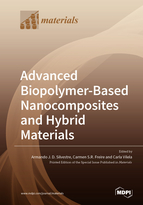Advanced Biopolymer-Based Nanocomposites and Hybrid Materials
A special issue of Materials (ISSN 1996-1944). This special issue belongs to the section "Biomaterials".
Deadline for manuscript submissions: closed (30 November 2020) | Viewed by 30903
Special Issue Editors
Interests: natural products; biorefinery; gc-ms; biobased polymers; HPLC-MS; extractives; biobased (nano)composites
Special Issues, Collections and Topics in MDPI journals
Interests: production and application of biogenic nanofibers (bacterial cellulose and protein fibrils); nanostructured biocomposites; bio-based materials for biomedical applications (wound healing, drug delivery and 3D-bioprinting); biocomposites and functional paper materials; chemical modification of (nano)cellulose fibers and other polysaccharides and their characterization and applications; chemistry of lignocellulosic materials (cellulose, wood, cork, etc.)
Special Issues, Collections and Topics in MDPI journals
Interests: sustainable use of biopolymers (nanocellulose, chitosan, pullulan, proteins, etc.) for the design of functional nanostructured materials for biomedical (e.g., drug delivery and wound healing) and technological (e.g., active packaging, fuel cells, and water remediation) applications
Special Issues, Collections and Topics in MDPI journals
Special Issue Information
Dear Colleagues,
The exploitation of naturally occurring polymers to engineer advanced nanocomposites and hybrid materials is the focus of increasing scientific activity, explained by the growing environmental concerns, and the interest in the peculiar features and multiple functionalities of these macromolecules. In fact, natural polymers, such as polysaccharides (e.g., cellulose, chitin, chitosan, starch, alginate, dextran, fucoidan, heparin, hyaluronan, and pullulan) and proteins (e.g., albumin, apoferritin, casein, collagen, fibrinogen, and gelatin), present a remarkable potential for the design of all kinds of materials for application in a multitude of domains, for example, in mechanics, optics, electronics, energy, environment, biology, and medicine.
This Special Issue will collect the work of world-leading scientists on the current developments in the field of multifunctional bio-based nanocomposites and hybrid materials with a particular emphasis on their production methodologies, properties, and prominent applications. Thus, any material related to biopolymer-based nanocomposite and hybrid materials manufactured with a plethora of partners, including (but not confined to) natural polymers, bioactive compounds, and inorganic nanoparticles, is more than welcome for the Special Issue “Advanced Biopolymer-Based Nanocomposites and Hybrid Materials”.
Prof. Armando J. D. Silvestre
Dr. Carmen S. R. Freire
Prof. Dr. Carla Vilela
Guest Editors
Manuscript Submission Information
Manuscripts should be submitted online at www.mdpi.com by registering and logging in to this website. Once you are registered, click here to go to the submission form. Manuscripts can be submitted until the deadline. All submissions that pass pre-check are peer-reviewed. Accepted papers will be published continuously in the journal (as soon as accepted) and will be listed together on the special issue website. Research articles, review articles as well as short communications are invited. For planned papers, a title and short abstract (about 100 words) can be sent to the Editorial Office for announcement on this website.
Submitted manuscripts should not have been published previously, nor be under consideration for publication elsewhere (except conference proceedings papers). All manuscripts are thoroughly refereed through a single-blind peer-review process. A guide for authors and other relevant information for submission of manuscripts is available on the Instructions for Authors page. Materials is an international peer-reviewed open access semimonthly journal published by MDPI.
Please visit the Instructions for Authors page before submitting a manuscript. The Article Processing Charge (APC) for publication in this open access journal is 2600 CHF (Swiss Francs). Submitted papers should be well formatted and use good English. Authors may use MDPI's English editing service prior to publication or during author revisions.
Keywords
- Biopolymers
- polysaccharides
- proteins
- nanocomposites
- hybrids
- aerogels
- films
- fibers
- biomedical applications
- technological applications









